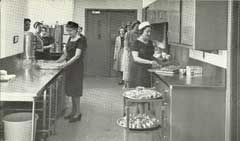History

The beginnings of Overbrook Presbyterian Church go back to 1888, when a group of twenty-three souls came together in the living room of Wistar Morris, a Quaker gentleman farmer who lived on what is now the campus of Friends’ Central School. Together, they began to dream of establishing a Presbyterian church in the area, so that Scotch-Irish immigrants who worked on his farm would have a place of their own to worship.

The following year, they built a little English Gothic chapel at the intersection of two dirt roads—which would later become City and Lancaster Avenues—for the grand sum of $14,767.
Overbrook was at that time a country church. But it did not stay that way for long. Philadelphia was a growing city. The surrounding neighborhood of Overbrook Farms was developed in the 1890s, as the first planned community on the main line of the Pennsylvania Railroad. Many of the new residents moving into the neighborhood found their way to Overbrook Presbyterian Church.

The church began to grow in numbers, and in 1905 the chapel was expanded to create a larger sanctuary which is still in use today. Other building additions were soon constructed to serve the growing congregation and its many programs.
Overbrook was also growing in mission and outreach. In 1903, the church established a hospital in a remote part of what was then called Siam, a place that few from here had ever visited before, but that they felt connected to out of Christian compassion. That hospital is still there today in Chiang Rai, Thailand, and is called Overbrook Hospital.

The longest-serving pastor in Overbrook’s history was George Emerson Barnes, who served from 1922 to 1948, and helped see the congregation through the Great Depression and World War II. He was very active in the ecumenical movement, and was instrumental in the founding of the World Council of Churches.
During the pastorate of Robert T. Williamson, from 1959 to 1970, the church felt the call to start a weekday preschool. It began with just a handful of students, but today has an enrollment of 150, and enjoys a reputation as one of the finest preschools in the area.

In the 1960s, the Overbrook neighborhood was beginning to become more ethnically diverse. Some churches in the area were resistant to these changes. But Overbrook opened its doors and welcomed everyone who came. In 1968, Betty Clayton became the first African-American member to join what had until then been an all-white church.
Since that time, Overbrook has grown more diverse, and more committed to urban ministry. David McMillan, pastor from 1983 to 2001, played a vital role in Overbrook's transformation.
In recent years, Overbrook has been blessed with renewed growth and vitality, and is discovering a new identity as a multicultural congregation. Over 125 years since its founding, our church is continuing its important ministry “at the crossroads.”

For more information on Overbrook’s history, there are two volumes available in the Church Office: "The Place Where Thy Glory Dwells: The Story of Overbrook Presbyterian Church" (1958), and "Overbrook Presbyterian Church: The Church at the Crossroads" (1989). And you can click here to view a Pictorial Supplement to the History of Overbrook Presbyterian Church dated November 1963.



